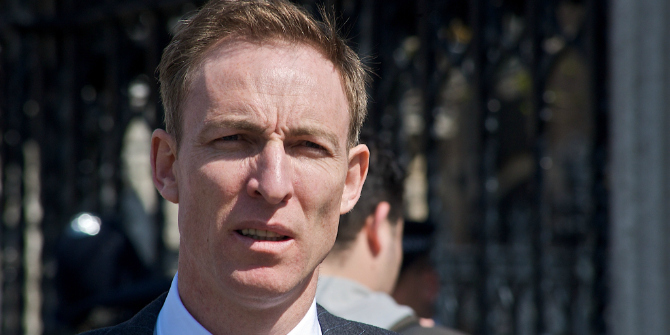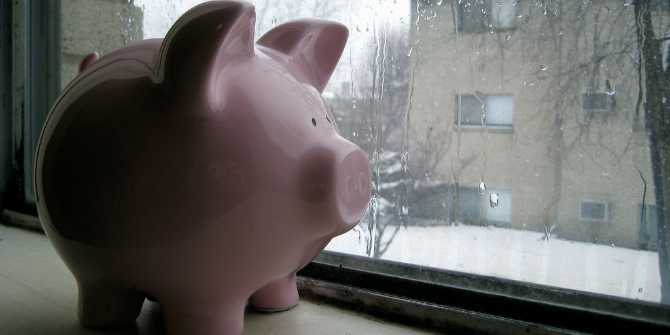 A policy bubble is a policy overreaction that is reinforced by positive feedback over a relatively long period of time. Policy bubbles impose social costs without producing offsetting benefits. Moshe Maor explores this phenomenon and explains how it may mature as a result of over-optimism and overconfidence among policymakers and the general public, or as a result of human herding and emotional contagion.
A policy bubble is a policy overreaction that is reinforced by positive feedback over a relatively long period of time. Policy bubbles impose social costs without producing offsetting benefits. Moshe Maor explores this phenomenon and explains how it may mature as a result of over-optimism and overconfidence among policymakers and the general public, or as a result of human herding and emotional contagion.
Policy scholars and practitioners claim that the Eurozone has been, and still is, a policy bubble akin to similar well-known suspecte policy bubbles like privatisation, nuclear deterrence, New Public Management (NPM) success in cutting costs, state-private partnership in the delivery of long term infrastructure projects, and the idea of sustainability. In order to prepare the conceptual ground to address this claim, I have tried to abstract out the most relevant features of a policy bubble by directing attention to the process that leads policymakers and the general public to misassign value to public policies over a relatively long period of time. Which factors drive the emergence of a gap between the (actual or perceived) cost of a policy and its (actual or perceived) contribution to its goals?
A public policy may be valued or devalued for reasons that are unrelated to its ability to affect goals. This is due, for example, to the use of rational and political considerations in policy evaluation, with the latter considerations often weakly related or completely unrelated to the policy goals. The empirical and theoretical neglect of this gap may be related to the fact that public policy scholars have so far been quite happy with the thermostat model, which suggests that the public functions like a common thermostat—it modifies its preferences for more spending downwards when budget appropriations increase and prefer increased spending when appropriations decrease. The problem is that the thermostat model only describes what occurs ‘on average’. Missing is an account of policies that fall at the extremes of the policy continuum, especially those whose development indicate a role for socio-psychological factors, as well as emotional and neurological ones.
A policy bubble is a real or perceived policy overreaction that is reinforced by positive feedback over a relatively long period of time. This type of policy imposes objective and/or perceived social costs without producing offsetting objective and/or perceived benefits over a considerable length of time. A case in point is when government spending over a policy problem increases due to public demand for more policy while the severity of the problem decreases over an extended period of time. Another case is when government raises ‘green’ or other standards due to public demand while the severity of the problem does not justify this move.
This is not to say that policy bubbles are always harmful. Some may indeed be harmful, but others may be significantly beneficial. A good example of the harmful consequences of a policy bubble is China’s Great Leap Forward in 1958-1961, during which agricultural collectivisation and aggressive promotion of industry was achieved through a swift diversion of agricultural labour and resources to industry, but which subsequently resulted in a famine that killed tens of millions. On the other hand, the railway mania in Britain during the 1840s that led to the vast expansion of the British railway system during the speculative investment period is a prime example of a beneficial policy bubble.
Drawing on insights from a variety of fields – including behavioural economics, psychology, sociology, political science and public policy – three phases of the life-cycle of a policy bubble may be identified: birth, maturity and death. A policy bubble may emerge when certain individuals perceive opportunities to gain from public policy or to exploit it by rallying support for the policy, promoting word-of-mouth enthusiasm and widespread endorsement of the policy, heightening expectations for further policy, and increasing demand for this policy. In particular, they stand to gain more if they find other individuals who act similarly. If that is the case, an oversupply of this policy is likely to follow. If this process is sustained over an extended period of time, a policy bubble may emerge. A policy bubble may also emerge when people are emotionally attracted to certain aspects of the policy, especially when the emotional quality of the policy idea matches the mood of the population. Policy bubbles arise, therefore, by way of ‘mobilisation of enthusiasm’ when the policy enacted exceeds its ability to affect policy goals.
A policy bubble grows and matures when positive feedback processes enter into the fray. Bursts of public optimism, for example, may encourage trend-chasers to subscribe to the policy, further arousing individuals’ enthusiasm, which then leads to oversupply of the policy at hand. By the same token, the reputation of a policy that is known for increasing efficiency (e.g., privatisation and contracting out) can be self-perpetuating. Such a reputation may be built on solid ground, but it may also lack solid footing and be based on past performances that are no longer valid, rumour or misconception. This implies that the trigger for the policy trend may be purely random, negligible, unstable or weak.
A policy bubble may mature as a result of over-optimism and overconfidence among policymakers and/or the general public, or as a result of imitation and human herding, as well as emotional contagion. Emotional entrepreneurs may play an important role in this process, trying to modify people’s emotions regarding the policy or the politicians that promote it and thereby shaping how people value this public policy. The role of the media in creating a self-sustained process is of paramount importance because it may overemphasize the value of policy by intensively reporting positive news regarding the policy and creating an investment culture around it. As long as there is anticipation for higher policy payoffs, positive feedback of high hopes overcomes negative feedback of crash expectations. However, since persistent policy payoffs cannot occur forever, elements of diminishing returns, at some point in time, are bound to replace positive feedback. Policy payoffs are likely to decline, and the bubble may gradually or abruptly burst. Losses incurred to individuals and to governments alike once the policy bubble bursts can be severe, sometimes even threatening the stability of the policy and political systems.
How can one identify a policy bubble? A policy bubble may be identified by measuring parliamentary concerns, media concerns, public opinion regarding the policy at hand, and the extent of a policy problem, against the budget allocation to said policy over the same period, preferably over 50 years or more. Measuring the operation of different transmission mechanisms in emotional contagion and human herding, particularly the spread of social influence and feeling , can also work to identify a policy bubble. Here, computer-aided content analysis of verbal and non-verbal communication in social networks, especially instant messaging, may capture emotional and social contagion. A further way to identify a policy bubble revolves around studying bubble expectations and individuals’ confidence through time by distributing a questionnaire to a random sample of the population, experts in the relevant policy sub-field, as well as decision makers, and to compare the results across time and nations.
To sum up, my interpretation of the process that leads to the emergence of policy bubbles allows for the possibility that different modes of policy overreaction lead to different types of human herding, thereby resulting in different types of policy bubbles. This interpretation has the added benefit of contributing to the explanation of economic, financial, technological and social bubbles as well.
This article is drawn from a paper published in the Governance Journal
Note: This article gives the views of the author, and not the position of the British Politics and Policy blog, nor of the London School of Economics. Please read our comments policy before posting.
 Moshe Maor is Professor of Political Science at the Hebrew University of Jerusalem. His full academic profile can be found here. Details regarding a 2015 ECPR workshop on policy bubbles can be found here.
Moshe Maor is Professor of Political Science at the Hebrew University of Jerusalem. His full academic profile can be found here. Details regarding a 2015 ECPR workshop on policy bubbles can be found here.








2 Comments